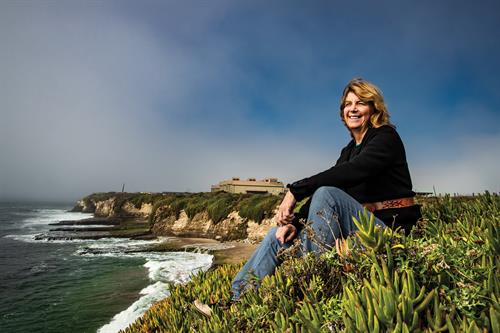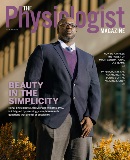Race Against Extinction
Terrie Williams’ work with big animals has had a lasting impact on conservation efforts.
By Starre Vartan
 How do you get a polar bear to walk on a treadmill? That’s a very real problem Terrie Williams, PhD, and her graduate student solved in 2018. Turns out turkey baby food is the trick—and it helps that bears are one of the easier animals
to train: “They are so food-motivated,” says Williams, who has studied a variety of apex predators, from circumspect wolves, to easily bored killer whales, to flighty dolphins. The toughest animals she’s worked with? African lions.
“They are the only animals we have had that have torn everything apart on the treadmill—ripped off the tread, created belt problems,” she says. Because after all, “they’re cats.”
How do you get a polar bear to walk on a treadmill? That’s a very real problem Terrie Williams, PhD, and her graduate student solved in 2018. Turns out turkey baby food is the trick—and it helps that bears are one of the easier animals
to train: “They are so food-motivated,” says Williams, who has studied a variety of apex predators, from circumspect wolves, to easily bored killer whales, to flighty dolphins. The toughest animals she’s worked with? African lions.
“They are the only animals we have had that have torn everything apart on the treadmill—ripped off the tread, created belt problems,” she says. Because after all, “they’re cats.”
Williams puts animals on treadmills (or in a swimming/aquatic version for marine mammals) because, despite the beloved status of most of these creatures, scientists don’t know enough about how their bodies work. In many cases, she doesn’t
even have the basics: “I don’t know the heart rates for 90 percent of the animals I work with,” she says. “It’s not that the science for these animals is wrong; it’s that there is no science for us to base conservation
plans on.”
Getting Animal Physiology Right
Getting that information is one part of her work as a professor of both animal physiology and exercise physiology at the University of California, Santa Cruz (UCSC). It’s also integral to the work she does as head of the ICE (Integrative Carnivore EcoPhysiology) Lab at UCSC, which, according to the lab’s website, investigates the “energetic, thermal, cardiovascular, neural and biomechanical biology of human athletes and apex predators, including African lions, pumas, tropical dolphins and seals, sea otters, and polar-living wolves, whales, bears and seals.”
Understanding these animals’ physiological differences is of life-and-death importance for their survival. For example, Williams points to the work she’s done on understanding different animals’ metabolic rates, which scientists like her are just beginning to map out. “For many wild carnivores, the resting metabolic rates are higher by two times what you’d predict off a Kleiber scale,” she says, referring to the 1930s allometric regression that predicts metabolic rate based on body size.
Before they knew that there could be such variability, researchers often had to develop conservation models where little or no data—or worse, incorrect data—were available. “If you get the basic metabolism wrong and you then multiply that by the population of predatory animals, your predictive models for how much prey they need to eat to survive can be grossly underestimated—a problem if you are trying to reintroduce large carnivores into a new habitat.”
These are the kinds of difficulties wildlife managers have to face all of the time. From lions in Africa to wolves and bears in the U.S., “we must get these numbers right to avoid human-animal conflicts. … We’re trying to catch up on
the science before the animals lose. And they are losing quickly,” Williams says. “The only hope we have of preserving them will be to get the science right.”
An Animal Focus
Williams’ current work is an extension of her interests since childhood. As a kid, she spent hours traipsing through the oak forests near her parochial school in New Jersey. And, despite her teachers’ admonishments, she kept returning to learn more about the animals she found there. Over time, her observations allowed her to “perceive the nearly invisible body and eye movements comprising animal language and predict an animal’s next move,” she writes in her 2012 book, “The Odyssey of KP2: An Orphan Seal and a Marine Biologist’s Fight to Save a Species.”
Animals weren’t her only inspiration. She says growing up in the 1970s during the rise of the women’s liberation movement might be her “biggest influence of all. Suddenly, young girls were being taught that they could be anything they wanted to be growing up.” Williams wanted to be a scientist and wildlife explorer, which propelled her to study science.
It was at Rutgers New Jersey Medical School that Williams decided to pursue physiology over her other passionate interest, medical illustration. She finished there with a PhD in exercise and environmental physiology. Then, she says, “I was the longest postdoc in the world, literally traveling the world for 15 years.”
She studied seals in the Antarctic, then moved from San Diego to Alaska to work on the Exxon Valdez oil spill where she was in charge of the Valdez sea otter rehab program. She helped clean off oil-soaked otters but also “collected tissues and necropsy samples to put together a unique database on how crude oil affects these animals” that’s still used today. From there, Williams was off to Hawaii to work for the U.S. Navy studying dolphin physiology, then to Washington, D.C., to the Office of Naval Research to help fund marine mammal research programs. Finally, she landed at UCSC, to teach and continue her research into large mammal physiology.
Williams says the winding road she took is one of the reasons she ended up where she is today. “People said I’d never get a job. But in the end I had so many stories to tell and experiences to share with students, it was actually easier than I thought to land an academic position,” she says.
“We are in a race against extinction, especially for large animals, so I’m feeling under immense pressure to work quickly these days,” she says. “The good news is if I can continue to convince people that funding this type of big
science is worthwhile, then we will have total freedom and total imagination to use our science to solve these problems across the world. That is our simple goal.”
The Physiologist Magazine
Read the Latest Issue
Don’t miss out on the latest topics in science and research.
View the Issue Archive
Catch up on all the issues of The Physiologist Magazine.
Contact Us
For questions, comments or to share your story ideas, email us or call 301.634.7314.


